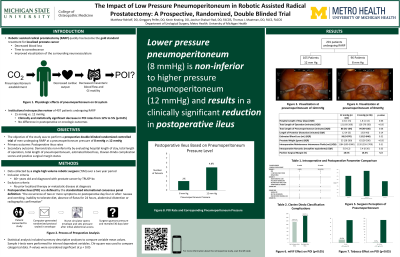Urological Surgery
Urological Surgery Podium Presentation: The Impact of Low Pressure Pneumoperitoneum in Robotic Assisted Radical Prostatectomy: A Prospective, Randomized, Double Blinded Trial

Has Audio
Introduction/Purpose: Robotic surgery has revolutionized postoperative outcomes across surgical specialties. However, the use of pneumoperitoneum comes with known risks given the change in physiological parameters that accompany its utilization. A recent internal review found a 7% decrease in postoperative ileus rates when utilizing a pneumoperitoneum of 12 mmHg over the standard 15 mmHg in robotic assisted radical prostatectomies (RARP). The purpose of this study is to prospectively evaluate the utility of lower pressure pneumoperitoneum by comparing 8 mmHg and 12 mmHg during RARP.
Methods or Case Description: Patients were randomly assigned to undergo robotic assisted radical prostatectomy at a pneumoperitoneum pressure of 12 mmHg or 8 mmHg. The primary outcome was development of postoperative ileus and secondary outcomes were length of operation, estimated blood loss and positive surgical margin status.
Outcomes: A total of 201 patients were analyzed; 96 patients at 8 mmHg and 105 patients at 12 mmHg. The groups were adequately matched as there were no differences between demographic parameters or medical comorbidities. There was a decrease in postoperative ileus rates with lower pneumoperitoneum pressures; 2% at 8 mmHg and 4.8% at 12 mmHg. There were no clinically significant differences in estimated blood loss, total length of operative time and positive margin status.
Conclusion: Lower pressure pneumoperitoneum during robotic assisted radical prostatectomy is non-inferior to higher pressure pneumoperitoneum levels and likely infers a decreased rate of postoperative ileus. The experienced surgeon may safely perform this operation at 8 mmHg and take advantage of the proposed benefits of this pressure setting.
Methods or Case Description: Patients were randomly assigned to undergo robotic assisted radical prostatectomy at a pneumoperitoneum pressure of 12 mmHg or 8 mmHg. The primary outcome was development of postoperative ileus and secondary outcomes were length of operation, estimated blood loss and positive surgical margin status.
Outcomes: A total of 201 patients were analyzed; 96 patients at 8 mmHg and 105 patients at 12 mmHg. The groups were adequately matched as there were no differences between demographic parameters or medical comorbidities. There was a decrease in postoperative ileus rates with lower pneumoperitoneum pressures; 2% at 8 mmHg and 4.8% at 12 mmHg. There were no clinically significant differences in estimated blood loss, total length of operative time and positive margin status.
Conclusion: Lower pressure pneumoperitoneum during robotic assisted radical prostatectomy is non-inferior to higher pressure pneumoperitoneum levels and likely infers a decreased rate of postoperative ileus. The experienced surgeon may safely perform this operation at 8 mmHg and take advantage of the proposed benefits of this pressure setting.
Learning Objectives:
- understand the importance of lower pressure pneumoperitoneum and its physiologic effects
- define the benefits of lower pressure pneumoperitoneum on ileus rates
- recognize the differences in varying pneumoperitoneum pressures during a robotic assisted radical prostatectomy
- MR
Matthew A. Rohloff, DO
Urological Surgery Resident
Metro Health: University of Michigan Health
Grand Rapids, MI, US
